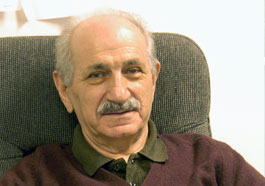
Kim Egiyan
K.Sh. Egiyan was born on 18 June 1935 in the Armenian village of Mirzik in the Khanlar region of Azerbaijan. Kim attended the Yerevan State University, Yerevan (Armenia) and in 1957, after finishing his studies at the university, he joined Yerevan Physics Institute as a junior scientist. In the nearly 50 years since then, Kim Egiyan dedicated his life to the development of the scientific program and international recognition of the institute, and to the education and development of young scientists.
Kim Egiyan started his scientific career in the field of cosmic ray physics. He was one of the active participant in the construction of the first magnetic spectrometer for the cosmic ray station on Mount Aragats in 1957-1959. In 1962, Kim started his scientific journey into experimental nuclear physics using accelerators. That year he was sent to Kharkov, Ukraine, to learn experimental techniques using accelerator beams and to develop an experimental program using the available low energy (300 MeV) electron beam of the small linac at Kharkov Physico-Technical Institute. Kim Egiyan developed a comprehensive and successful program for studying nuclear matter using low energy electrons and in 1972, based on the experimental results, he defended his PhD thesis and became a doctor of physics and mathematics. Then in 1983 he earned the highest science degree awarded in the then-Soviet Union, a Doctor of Science.
After earning his doctoral degree, Kim was appointed as a group leader at Yerevan Physics Institute to develop and conduct experiments using the newly built Yerevan electron synchrotron with energies up 4.5 GeV. Soon after organizing the group, Kim presented a complete experimental program for studying so-called "cumulative" effects in the photoproduction on nuclei. Later this program was expanded to include electroproduction reactions. Under his leadership, the group successfully built and operated sophisticated experimental equipment, conducted many experiments using both photon and electron beams and published more than 100 papers. Kim Egiyan was the thesis advisor for six successfully completed PhD works.
In 1985, when word was out that a new, continuous electron accelerator would be built in Newport News, VA (USA), Kim started putting together a physics program for studying short range nuclear effects using high energy, high intensity and high precision electron beams. In 1986, he was invited to a workshop at the Continuous Electron Beam Accelerator Facility (CEBAF) to discuss the experimental program for nuclear research at future electron accelerators. On that visit Kim "put in place the first corner stone" of the scientific collaboration between Yerevan Physics Institute and Jefferson Lab. His dedication and hard work made this an extremely successful and fruitful collaboration. More than 30 physicists from Yerevan worked under his leadership in the construction of large-scale detector components for CEBAF. He developed a comprehensive program for studying the short range nucleon-nucleon correlations in nuclei. His work on nucleon-nucleon correlations have made a great impact on our understanding of the structure of nuclei. His lifetime of scientific accomplishments were recognized by Armenia when the nation awarded him the Anania Shirakatsi Medal, which recognizes scientists for notable activities in economics, engineering, natural science and technology.
Up to the very last minutes of his life, Kim continued the work that he loved. Kim Egiyan was a man of vision and principles. His contributions to the field of experimental nuclear physics are hard to overestimate. Kim died on Monday. He will be deeply missed by every one.
Stepan Stepanyan
Hall B Staff Scientist
More information:

